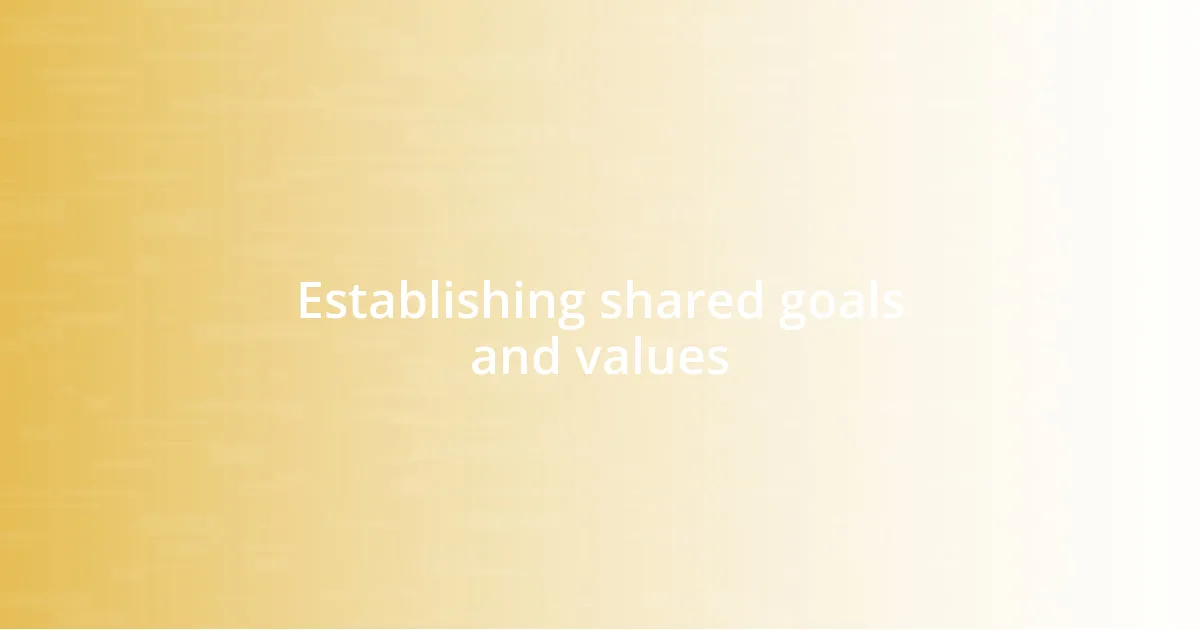Key takeaways:
- Collaboration thrives in an environment of psychological safety, trust, and open communication, allowing diverse perspectives to flourish.
- Identifying and addressing barriers, such as communication issues and lack of role clarity, is crucial for effective teamwork.
- Regular check-ins and team-building activities enhance relationships and foster a culture of collaboration, making each member feel valued.
- Measuring collaboration effectiveness involves both quantitative metrics and qualitative feedback to understand team dynamics and improve practices.

Understanding collaboration in teams
Collaboration in teams is more than just working together; it’s about harnessing diverse perspectives to drive innovation. I remember a project where each team member brought their unique expertise to the table. Watching different viewpoints clash and then merge into a groundbreaking idea was exhilarating. It made me realize how vital it is to create an environment where everyone feels valued.
When I reflect on my experiences, I often wonder: What happens when individuals do not feel free to express their opinions? In one team I was part of, a few members hesitated to share their thoughts, fearing criticism. This led to missed opportunities and a stagnation of ideas. It’s crucial to foster psychological safety so that everyone feels empowered and heard.
I’ve also seen how small, intentional actions can spark collaboration. For example, initiating casual brainstorming sessions allowed us to connect beyond our roles. I distinctly remember the energy in those discussions—laughter, lightbulb moments, and a shared sense of purpose. It highlighted for me that collaboration thrives in an atmosphere of trust and open communication. Isn’t it fascinating how a simple shift in approach can lead to remarkable outcomes?

Identifying barriers to collaboration
Identifying barriers to collaboration can be a pivotal step in nurturing a more cohesive team environment. I recall a time when my team struggled with communication, largely due to differing opinions on project directions. Tensions brewed, and instead of asking questions to clarify, many of us retreated into silence. This experience taught me that unresolved conflicts can become significant roadblocks, undermining our ability to work together effectively.
Another challenge I observed was the lack of clear roles and responsibilities within the team. It created confusion, leading to duplicated efforts or, worse, tasks being overlooked altogether. I remember a particular project where we had miscommunication about who was responsible for what, resulting in late submissions and frustration. Establishing clarity in roles not only enhances accountability but also encourages collaboration, as team members know exactly how to contribute.
Lastly, I’ve found that technological barriers can also hinder collaboration. In one instance, our reliance on outdated software led to difficulties in sharing information efficiently. I remember sitting in frustration as we struggled to keep our files organized. Embracing modern tools can significantly improve our workflow and connectivity. Recognizing these barriers is essential to transforming our collaborative efforts into something extraordinary.
| Barrier Type | Impact on Collaboration |
|---|---|
| Communication Issues | Leads to misunderstandings and conflicts. |
| Lack of Role Clarity | Results in confusion and decreased accountability. |
| Technological Barriers | Hinders information sharing and coordination. |

Encouraging open communication practices
Creating an environment where open communication thrives is essential for collaboration. In my experience, I’ve found that regular check-ins can make a monumental difference. These meetings aren’t always about project updates; they serve as a safe space for team members to voice concerns, share ideas, and suggest improvements. I remember one such session where a team member hesitated, but once they started sharing, others quickly followed suit. The flood of ideas that came forth was incredible, and it felt like we were unlocking hidden potential.
To cultivate these open communication practices, consider the following strategies:
- Implement regular team check-ins: Set up weekly or bi-weekly meetings to encourage sharing beyond just project updates.
- Encourage feedback: Create avenues for constructive criticism, allowing everyone to voice their thoughts openly without fear of repercussion.
- Use digital tools: Leverage platforms like Slack or Microsoft Teams to facilitate ongoing dialogues, even in between meetings.
- Celebrate contributions: Recognize and appreciate team members who share ideas or take risks. This fosters a sense of value and belonging.
- Lead by example: As a leader, openly communicate your own challenges and encourage a culture of vulnerability.
Embracing these practices can transform the dynamic within teams, making each member feel more connected and engaged. It’s about building that bridge where dialogues flourish.

Implementing team-building activities
In my experience, team-building activities can genuinely reinvigorate a group’s collaborative spirit. I once organized a simple outdoor retreat where we engaged in trust exercises and problem-solving games. Watching my team members go from tentative to eager participants was a profound reminder of how these activities can break down barriers and foster camaraderie. Have you ever witnessed that spark of creativity when team members interact in a relaxed setting? It’s like watching a team metamorphose from a collection of individuals into a cohesive unit.
Another effective approach I’ve embraced is incorporating team-building activities into our regular meetings. For instance, I’d often start with a quick icebreaker that encourages everyone to share something personal or fun. I vividly recall one meeting where we shared our favorite childhood games, and it opened up a delightful dialogue that revealed our personalities. These moments not only lighten the mood but also cultivate relationships, making collaboration feel more natural.
Additionally, I’ve learned the power of tailored team-building initiatives. I once gathered my team to create a community project, where we collaborated on a local charity initiative. The sense of purpose and collective achievement not only deepened our teamwork but also highlighted the unique skills each member brought to the table. How often do we get the chance to leverage our professional capabilities for a cause we care about? It’s truly encouraging to see how aligning personal values with team goals can enhance collaboration, creating a workplace that feels both meaningful and engaging.

Establishing shared goals and values
Establishing shared goals and values is crucial for fostering a collaborative environment. I’ve found that when a team collectively defines its objectives, it creates a magnetic sense of unity. For example, I once facilitated a workshop where everyone contributed to outlining our project goals. The energy in the room shifted; the process transformed a disparate group into a focused collective, committed to a common purpose. Isn’t it inspiring to witness a team rally around shared aspirations?
Communicating core values openly brings an extra layer of depth to collaboration. I distinctly remember a time when we revisited our values during a team retreat. As we discussed integrity, innovation, and teamwork, it became clear how these principles influenced our daily actions. It resonated with everyone, and I could feel a renewed enthusiasm to align our efforts. When team members connect their personal values to the organization’s mission, they are more likely to invest their energy and creativity into collaborative projects.
Furthermore, setting measurable goals can serve as a powerful motivator. I’ve implemented this approach during quarterly planning sessions, where we identified specific outcomes we wanted to achieve together. One year, our target was to improve client satisfaction by 20%. We broke it down into actionable steps, and witnessing the team rally around that measurable goal was phenomenal. It encouraged accountability and a sense of shared ownership, making collaboration not just a nice idea, but a fundamental pillar of our success. How often do we stop to appreciate the strength that comes from shared ambitions?

Recognizing and celebrating teamwork
Recognizing and celebrating teamwork is essential in cultivating a collaborative atmosphere. I remember the rush of excitement during a monthly meeting when I introduced a “team player spotlight.” Each time we highlighted an individual’s contributions, you could see the smiles and hear the laughter—acknowledging efforts not only boosts morale but also fosters a culture where everyone feels valued. Have you ever noticed how recognition can spark a chain reaction of motivation within a team?
One of the most memorable moments I’ve had was when we organized a “Success Celebration” at the end of a challenging project. We decorated the office, shared a meal, and reflected on our journey together. The camaraderie built during that event was palpable. It wasn’t just about celebrating victories; it was about recognizing the struggles and teamwork that got us there. This kind of recognition can deepen bonds; don’t you think it’s vital to pause and appreciate the collective effort behind every success?
Our team also embraced the idea of peer nominations for monthly awards, allowing everyone to recognize each other’s contributions. This initiative brought about a beautiful sense of accountability and appreciation, as team members learned to look for the good in one another. There was a genuine emotional connection that blossomed from these affirmations. I often ask myself: How often do we truly celebrate not just the end result, but the collaboration that makes it possible? It’s a powerful reminder that every little achievement is a collective effort worthy of recognition.

Measuring collaboration effectiveness
Measuring collaboration effectiveness is an integral part of ensuring that our efforts are yielding the desired outcomes. In my experience, I’ve found that using specific metrics, such as joint project completion rates or the frequency of cross-departmental engagements, really helps pinpoint how well we’re working together. One project I led was an interdepartmental initiative designed to streamline communication. By analyzing feedback and progress reports, I could see not only what was working but also where we needed to make adjustments. Isn’t it fascinating how hard data can illuminate the nuances of teamwork?
Feedback from team members provides invaluable qualitative insights. I often hold informal check-ins after major projects to gauge feelings and observations. I recall a time when we wrapped up a complicated task, and the general sentiment was mixed; while we succeeded, some felt unheard during discussions. That insight prompted a re-evaluation of our collaboration strategies. It made me realize that measuring isn’t just about numbers—it’s about understanding emotions and experiences. How often do we consider the human element in our assessments of effectiveness?
Lastly, implementing collaboration tools can provide both ongoing metrics and a space for team reflections. I remember experimenting with a project management tool that allowed us to share updates and concerns in real time. The ability to see each other’s contributions transformed our workflow, creating consistent accountability. Not only were we able to measure our progress, but the tool also fostered open communication, making collaboration feel more cohesive and purposeful. It’s a compelling reminder of how technology can enhance our collaborative efforts, don’t you think?















